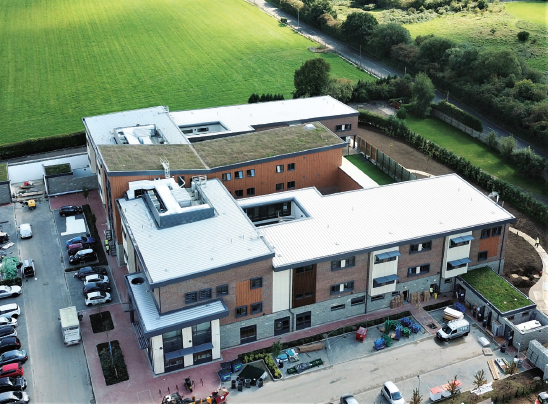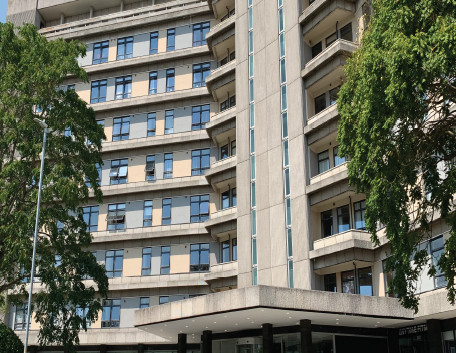Call us on
+44 (0)1268 777871Inverted Roof Solutions from Proteus
In other roofing build ups, the waterproofing layer sits above the insulation. Inverted roofs reverse this arrangement, placing the waterproofing membrane beneath the insulation layer. This reversed arrangement is suitable for commercial and residential projects alike. In other roofing build ups, the waterproofing layer sits above the insulation. Inverted roofs reverse this arrangement, placing the waterproofing membrane beneath the insulation layer. This reversed arrangement is suitable for commercial and residential projects alike.
Thermal Insulation and Energy Efficiency
Inverted roofs maintain a consistent temperature within the building envelope. The insulation layer, shielded from the elements, traps heat during colder months to reduce energy consumption. Inverted roofs maintain a consistent temperature within the building envelope. The insulation layer, shielded from the elements, traps heat during colder months to reduce energy consumption.
Waterproofing Protection Against the Weather
By placing the waterproofing membrane beneath the insulation, inverted roofs provide an additional layer of protection against the elements, safeguarding each building from moisture intrusion and damage from weather conditions.
Extended Lifespan and Resistance to UV Degradation
Inverted roofs have a notable lifespan, often exceeding 50 years. The insulation layer acts as a protective barrier, shielding the waterproofing membrane from direct sunlight and UV radiation, which can cause premature deterioration. This results in a long-lasting, durable roofing system that requires minimal maintenance.

Environmental and Sustainability Friendly
Proteus Waterproofing's flagship system, Proteus Cold Melt®, reflects our commitment to sustainability. This elastomeric, seamless, cold-applied membrane incorporates recycled rubber crumb and other organically grown products, reducing the environmental impact of roofing material production and disposal making it ideal for inverted roofs.
BBA Certified for Durability
Proteus Cold Melt® has been tested and certified by the British Board of Agrément (BBA) to last for the lifetime of the substrate on which it is installed. This certification provides assurance of the membrane's durability and performance.

View our Inverted & Protected Roofs products

Cold Melt®
Cold Melt® incorporates recycled rubber crumb and other organically grown products to create an elastomeric, seamless, cold applied membrane that can be applied to a wide range of substrates including concrete, asphalt and timber.

Proteus Hot Melt®
Proteus Hot Melt® is a hot-applied modified bitumen, reinforced with reinforced with Proteus Hot Melt Fleece, used in conjunction with a bitumen roofing.
FAQs
-
Can an inverted roof be installed on my existing building?
Yes, an inverted roof can be installed on existing buildings. However, an installation cannot be completed until your roof has been inspected by a qualified professional to ensure that it can support the weight of an inverted roof.
-
How much maintenance does an inverted roof require?
Inverted roofs typically require low maintenance. The ballast layer should be inspected once or twice a year for any damage or erosion. The insulation layer and waterproofing membrane should also be inspected periodically for any leaks or damage.
-
What are the benefits of inverted roofs?
Inverted roofs benefits include:
• The waterproofing layer in an inverted roof is protected from the elements, which helps to extend the lifespan of the roof
• Inverted roofs can reduce stormwater runoff by absorbing rainwater into the insulation layer
-
What are the best materials for an inverted roof?
The materials for an inverted roof will depend on the specific needs of the project. However, some materials used in inverted roofs include:
• The waterproofing membrane will protect the insulation layer and the underlying structure
• The insulation layer helps to improve energy efficiency. We will advise you on the most suitable type of insulation to use on your project
• The ballast layer holds the insulation layer in place and protects the waterproofing layer. Gravel and pavers are two types of ballast used in inverted roofs
• Green roofs can be used on inverted roofs to provide additional benefits such as reduced stormwater runoff.
-
What is an inverted roof?
An inverted roof is a type of roof where the waterproofing layer is installed below the insulation layer.
There are two main types of inverted roofs: cold and warm.
• Cold inverted roofs use a ballast layer, such as gravel or pavers, to hold the insulation layer in place and protect the waterproofing layer
• Warm inverted roofs use a green roof or other vegetative layer to hold the insulation layer in place and protect the waterproofing layer
Case studies

Curzon Street, London
7 Curzon Street, a prestigious residential block in Mayfair, London, required a refurbishment to the terrace roofs and high-level flat roofs.

The Panorama, Ashford, Kent
The Panorama, a large mixed use residential and office block in Ashford, Kent, required extensive refurbishment to the various flat roofs.










